Elaeagnus latifolia Fruit Extract Ameliorates High-Fat Diet-Induced Obesity in Mice and Alleviates Macrophage-Induced Inflammation in Adipocytes In Vitro
Abstract
1. Introduction
2. Materials and Methods
2.1. Preparation of Aqueous Extracts of EL Fruits
2.2. Determination of Total Phytochemical Contents
2.3. Determination of In Vitro Antioxidant Activity
2.4. Characterization of Bioactive Contents
2.5. Animal Study
2.6. Histological Examination of EAT
2.7. Measurement of Lipids in EAT
2.8. Measurement of Oxidative Stress
2.9. Cell Culture
2.10. Cell Viability
2.11. Measurement of Nitric Oxide (NO) Production
2.12. Flow Cytometer Analysis
2.13. Measurement of Cytokines
2.14. Genes Expression Analysis
2.15. Protein Expression Analysis
2.16. Sample Preparation and Proteomic Analysis
2.17. Statistical Analysis
3. Results
3.1. Total Bioactive Compounds and Antioxidant Activity of the EL Fruit Extract
3.2. EL Fruit Extract Improves Obesity in HFD-Fed Mice
3.3. EL Fruit Extract Reduces the Adipocyte Size by Increasing Adipogenesis
3.4. EL Fruit Extract Attenuates HFD-Induced Inflammation and Oxidative Damage
3.5. EL Fruit Extract Diminishes Macrophage Infiltration Surrounding the Adipocytes
3.6. EL Fruit Extract Attenuates ROS and NO Production in Macrophages
3.7. EL Fruit Extract Attenuates Inflammation by Reducing the Maturation and Cytokine Secretion of Activated Macrophages
3.8. EL Fruit Extract Attenuates LPS-Induced Macrophages by Reducing the Energy-Producing Pathways
4. Discussion
5. Conclusions
Supplementary Materials
Author Contributions
Funding
Institutional Review Board Statement
Informed Consent Statement
Data Availability Statement
Conflicts of Interest
References
- Longo, M.; Zatterale, F.; Naderi, J.; Parrillo, L.; Formisano, P.; Raciti, G.A.; Beguinot, F.; Miele, C. Adipose Tissue Dysfunction as Determinant of Obesity-Associated Metabolic Complications. Int. J. Mol. Sci. 2019, 20, 2358. [Google Scholar] [CrossRef] [PubMed]
- Saltiel, A.R.; Olefsky, J.M. Inflammatory mechanisms linking obesity and metabolic disease. J. Clin. Investig. 2017, 127, 1–4. [Google Scholar] [CrossRef] [PubMed]
- Dhawan, D.; Sharma, S. Abdominal Obesity, Adipokines and Non-communicable Diseases. J. Steroid Biochem. Mol. Biol. 2020, 203, 105737. [Google Scholar] [CrossRef] [PubMed]
- Eslam, M.; Newsome, P.N.; Sarin, S.K.; Anstee, Q.M.; Targher, G.; Romero-Gomez, M.; Zelber-Sagi, S.; Wong, V.W.-S.; Dufour, J.-F.; Schattenberg, J.M.; et al. A new definition for metabolic dysfunction-associated fatty liver disease: An international expert consensus statement. J. Hepatol. 2020, 73, 202–209. [Google Scholar] [CrossRef] [PubMed]
- Vishvanath, L.; Gupta, R.K. Contribution of adipogenesis to healthy adipose tissue expansion in obesity. J. Clin. Investig. 2019, 129, 4022–4031. [Google Scholar] [CrossRef]
- Jun, J.C.; Devera, R.; Unnikrishnan, D.; Shin, M.-K.; Bevans-Fonti, S.; Yao, Q.; Rathore, A.; Younas, H.; Halberg, N.; Scherer, P.E.; et al. Adipose HIF-1α causes obesity by suppressing brown adipose tissue thermogenesis. J. Mol. Med. 2017, 95, 287–297. [Google Scholar] [CrossRef]
- Kawai, T.; Autieri, M.V.; Scalia, R. Adipose tissue inflammation and metabolic dysfunction in obesity. Am. J. Physiol. Cell Physiol. 2020, 320, C375–C391. [Google Scholar] [CrossRef]
- Bajpai, V.K.; Alam, M.B.; Quan, K.T.; Kwon, K.-R.; Ju, M.-K.; Choi, H.-J.; Lee, J.S.; Yoon, J.-I.; Majumder, R.; Rather, I.A.; et al. Antioxidant efficacy and the upregulation of Nrf2-mediated HO-1 expression by (+)-lariciresinol, a lignan isolated from Rubia philippinensis, through the activation of p38. Sci. Rep. 2017, 7, 46035. [Google Scholar] [CrossRef]
- Liao, J.; Guo, J.; Niu, Y.; Fang, T.; Wang, F.; Fan, Y. Flavonoids from Lycium barbarum leaves attenuate obesity through modulating glycolipid levels, oxidative stress, and gut bacterial composition in high-fat diet-fed mice. Front. Nutr. 2022, 9, 972794. [Google Scholar] [CrossRef]
- Nouri, M.; Shateri, Z.; Faghih, S. The relationship between intake of fruits, vegetables and dairy products with overweight and obesity in a large sample in Iran: Findings of STEPS 2016. Front. Nutr. 2023, 9, 1082976. [Google Scholar] [CrossRef]
- Rymbai, H.; Verma, V.K.; Talang, H.; Assumi, S.R.; Devi, M.B.; Vanlalruati; Sangma, R.H.C.; Biam, K.P.; Chanu, L.J.; Makdoh, B.; et al. Biochemical and antioxidant activity of wild edible fruits of the eastern Himalaya, India. Front. Nutr. 2023, 10, 1039965. [Google Scholar] [CrossRef] [PubMed]
- Dasila, K.; Singh, M. Bioactive compounds and biological activities of Elaegnus latifolia L.: An underutilized fruit of North-East Himalaya, India. S. Afr. J. Bot. 2022, 145, 177–185. [Google Scholar] [CrossRef]
- Panja, S.; Chaudhuri, D.; Baban Ghate, N.; Le Minh, H.; Mandal, N. In vitro assessment of phytochemicals, antioxidant and DNA protective potential of wild edible fruit of Elaeagnus latifolia Linn. Fruits 2014, 69, 303–314. [Google Scholar] [CrossRef]
- Munkong, N.; Ruxsanawet, K.; Ariyabukalakorn, V.; Mueangchang, W.; Sangkham, S.; Silangirn, P.; Thim-uam, A.; Naowaboot, J.; Somparn, N.; Yoysungnoen, B. Hepatoprotective effects of Elaeagnus latifolia fruit extract against acetaminophen-induced hepatotoxicity in mice: Mechanistic insights. J. Funct. Foods 2024, 114, 106077. [Google Scholar] [CrossRef]
- Perdicaro, D.J.; Rodriguez Lanzi, C.; Gambarte Tudela, J.; Miatello, R.M.; Oteiza, P.I.; Vazquez Prieto, M.A. Quercetin attenuates adipose hypertrophy, in part through activation of adipogenesis in rats fed a high-fat diet. J. Nutr. Biochem. 2020, 79, 108352. [Google Scholar] [CrossRef]
- Shen, C.-Y.; Hao, Y.-F.; Hao, Z.-X.; Liu, Q.; Zhang, L.; Jiang, C.-P.; Jiang, J.-G. Flavonoids from Rosa davurica Pall. fruits prevent high-fat diet-induced obesity and liver injury via modulation of the gut microbiota in mice. Food Funct. 2021, 12, 10097–10106. [Google Scholar] [CrossRef]
- Mohammed, E.A.; Abdalla, I.G.; Alfawaz, M.A.; Mohammed, M.A.; Al Maiman, S.A.; Osman, M.A.; Yagoub, A.E.A.; Hassan, A.B. Effects of Extraction Solvents on the Total Phenolic Content, Total Flavonoid Content, and Antioxidant Activity in the Aerial Part of Root Vegetables. Agriculture 2022, 12, 1820. [Google Scholar] [CrossRef]
- Onsa-Ard, A.; Thongboontho, R.; Munkong, N.; Phromnoi, K.; Ontawong, A.; Pengnet, S.; Thim-Uam, A. Anti-Inflammatory Effects of Red Rice Bran Extract Ameliorate Type I Interferon Production via STING Pathway. Foods 2022, 11, 1622. [Google Scholar] [CrossRef]
- Thongboontho, R.; Petcharat, K.; Munkong, N.; Khonthun, C.; Boondech, A.; Phromnoi, K.; Thim-Uam, A. Effects of Pogonatherum paniceum (Lamk) Hack extract on anti-mitochondrial DNA mediated inflammation by attenuating Tlr9 expression in LPS-induced macrophages. Nutr. Res. Pract. 2023, 17, 827–843. [Google Scholar] [CrossRef]
- Munkong, N.; Hansakul, P.; Yoysungnoen, B.; Wongnoppavich, A.; Sireeratawong, S.; Kaendee, N.; Lerdvuthisopon, N. Vasoprotective effects of rice bran water extract on rats fed with high-fat diet. Asian Pac. J. Trop. Biomed. 2016, 6, 778–784. [Google Scholar] [CrossRef]
- Panpetch, W.; Kullapanich, C.; Dang Cong, P.; Visitchanakun, P.; Saisorn, W.; Wongphoom, J.; Wannigama Dhammika, L.; Thim-uam, A.; Patarakul, K.; Somboonna, N.; et al. Candida Administration Worsens Uremia-Induced Gut Leakage in Bilateral Nephrectomy Mice, an Impact of Gut Fungi and Organismal Molecules in Uremia. mSystems 2021, 6, e01187-20. [Google Scholar] [CrossRef] [PubMed]
- Kuninaka, Y.; Ishida, Y.; Ishigami, A.; Nosaka, M.; Matsuki, J.; Yasuda, H.; Kofuna, A.; Kimura, A.; Furukawa, F.; Kondo, T. Macrophage polarity and wound age determination. Sci. Rep. 2022, 12, 20327. [Google Scholar] [CrossRef] [PubMed]
- Yao, J.; Wu, D.; Qiu, Y. Adipose tissue macrophage in obesity-associated metabolic diseases. Front. Immunol. 2022, 13, 977485. [Google Scholar] [CrossRef] [PubMed]
- Henn, R.E.; Elzinga, S.E.; Glass, E.; Parent, R.; Guo, K.; Allouch, A.M.; Mendelson, F.E.; Hayes, J.; Webber-Davis, I.; Murphy, G.G.; et al. Obesity-induced neuroinflammation and cognitive impairment in young adult versus middle-aged mice. Immun. Ageing 2022, 19, 67. [Google Scholar] [CrossRef] [PubMed]
- Liu, C.-Y.; Chang, C.-W.; Lee, H.-C.; Chen, Y.-J.; Tsai, T.-H.; Chiau, J.-S.C.; Wang, T.-E.; Tsai, M.-C.; Yeung, C.-Y.; Shih, S.-C. Metabolic Damage Presents Differently in Young and Early-Aged C57BL/6 Mice Fed a High-Fat Diet. Int. J. Gerontol. 2016, 10, 105–111. [Google Scholar] [CrossRef][Green Version]
- Kovacs, P.; Hajnal, A. Short-term high-fat diet consumption increases body weight and body adiposity and alters brain stem taste information processing in rats. Chem. Senses 2022, 47, bjac020. [Google Scholar] [CrossRef]
- Chrysafi, P.; Perakakis, N.; Farr, O.M.; Stefanakis, K.; Peradze, N.; Sala-Vila, A.; Mantzoros, C.S. Leptin alters energy intake and fat mass but not energy expenditure in lean subjects. Nat. Commun. 2020, 11, 5145. [Google Scholar] [CrossRef]
- Mahboob, A.; Samuel, S.M.; Mohamed, A.; Wani, M.Y.; Ghorbel, S.; Miled, N.; Büsselberg, D.; Chaari, A. Role of flavonoids in controlling obesity: Molecular targets and mechanisms. Front. Nutr. 2023, 10, 1177897. [Google Scholar] [CrossRef]
- Li, R.; Zhu, Q.; Wang, X.; Wang, H. Mulberry leaf polyphenols alleviated high-fat diet-induced obesity in mice. Front. Nutr. 2022, 9, 979058. [Google Scholar] [CrossRef]
- Kim, J.; Lee, J.-Y.; Kim, C.Y.J.F. Allium macrostemon whole extract ameliorates obesity-induced inflammation and endoplasmic reticulum stress in adipose tissue of high-fat diet-fed C57BL/6N mice. Food Nutr. Res. 2023, 67, 1–13. [Google Scholar] [CrossRef]
- Hoek-van den Hil, E.F.; van Schothorst, E.M.; van der Stelt, I.; Swarts, H.J.M.; van Vliet, M.; Amolo, T.; Vervoort, J.J.M.; Venema, D.; Hollman, P.C.H.; Rietjens, I.M.C.M.; et al. Direct comparison of metabolic health effects of the flavonoids quercetin, hesperetin, epicatechin, apigenin and anthocyanins in high-fat-diet-fed mice. Genes Nutr. 2015, 10, 23. [Google Scholar] [CrossRef] [PubMed]
- Feng, B.; Meng, R.; Huang, B.; Shen, S.; Bi, Y.; Zhu, D. Silymarin alleviates hepatic oxidative stress and protects against metabolic disorders in high-fat diet-fed mice. Free Radic. Res. 2016, 50, 314–327. [Google Scholar] [CrossRef] [PubMed]
- Cercato, L.M.; Oliveira, J.P.; Souza, M.T.S.; Andrade, N.; Martel, F.; Camargo, E.A. Effect of flavonoids in preclinical models of experimental obesity. PharmaNutrition 2021, 16, 100260. [Google Scholar] [CrossRef]
- Madsen, M.S.; Siersbæk, R.; Boergesen, M.; Nielsen, R.; Mandrup, S. Peroxisome Proliferator-Activated Receptor γ and C/EBPα Synergistically Activate Key Metabolic Adipocyte Genes by Assisted Loading. Mol. Cell. Biol. 2014, 34, 939–954. [Google Scholar] [CrossRef]
- Richard, A.J.; Burris, T.P.; Sanchez-Infantes, D.; Wang, Y.; Ribnicky, D.M.; Stephens, J.M. Artemisia extracts activate PPARγ, promote adipogenesis, and enhance insulin sensitivity in adipose tissue of obese mice. Nutrition 2014, 30, S31–S36. [Google Scholar] [CrossRef]
- Ramírez, N.M.; Toledo, R.C.L.; Moreira, M.E.C.; Martino, H.S.D.; Benjamin, L.d.A.; de Queiroz, J.H.; Ribeiro, A.Q.; Ribeiro, S.M.R. Anti-obesity effects of tea from Mangifera indica L. leaves of the Ubá variety in high-fat diet-induced obese rats. Biomed. Pharmacother. 2017, 91, 938–945. [Google Scholar] [CrossRef]
- Naowaboot, J.; Chung, C.H.; Choi, R.; Pannangpetch, P. Umbelliferone Increases the Expression of Adipocyte-Specific Genes in 3 T3-L1 Adipocyte. Phytother. Res. 2014, 28, 1671–1675. [Google Scholar] [CrossRef]
- Hammarstedt, A.; Gogg, S.; Hedjazifar, S.; Nerstedt, A.; Smith, U. Impaired Adipogenesis and Dysfunctional Adipose Tissue in Human Hypertrophic Obesity. Physiol. Rev. 2018, 98, 1911–1941. [Google Scholar] [CrossRef]
- Hildebrandt, X.; Ibrahim, M.; Peltzer, N. Cell death and inflammation during obesity: “Know my methods, WAT(son)”. Cell Death Differ. 2023, 30, 279–292. [Google Scholar] [CrossRef]
- Yun, Z.; Maecker, H.L.; Johnson, R.S.; Giaccia, A.J. Inhibition of PPARγ2 Gene Expression by the HIF-1-Regulated Gene DEC1/Stra13: A Mechanism for Regulation of Adipogenesis by Hypoxia. Dev. Cell 2002, 2, 331–341. [Google Scholar] [CrossRef]
- Kamei, N.; Tobe, K.; Suzuki, R.; Ohsugi, M.; Watanabe, T.; Kubota, N.; Ohtsuka-Kowatari, N.; Kumagai, K.; Sakamoto, K.; Kobayashi, M.; et al. Overexpression of Monocyte Chemoattractant Protein-1 in Adipose Tissues Causes Macrophage Recruitment and Insulin Resistance. J. Biol. Chem. 2006, 281, 26602–26614. [Google Scholar] [CrossRef] [PubMed]
- Castoldi, A.; Naffah de Souza, C.; Câmara, N.O.S.; Moraes-Vieira, P.M. The Macrophage Switch in Obesity Development. Front. Immunol. 2016, 6, 637. [Google Scholar] [CrossRef] [PubMed]
- Kang, Y.E.; Kim, J.M.; Joung, K.H.; Lee, J.H.; You, B.R.; Choi, M.J.; Ryu, M.J.; Ko, Y.B.; Lee, M.A.; Lee, J.; et al. The Roles of Adipokines, Proinflammatory Cytokines, and Adipose Tissue Macrophages in Obesity-Associated Insulin Resistance in Modest Obesity and Early Metabolic Dysfunction. PLoS ONE 2016, 11, e0154003. [Google Scholar] [CrossRef] [PubMed]
- Li, X.; Ren, Y.; Chang, K.; Wu, W.; Griffiths, H.R.; Lu, S.; Gao, D. Adipose tissue macrophages as potential targets for obesity and metabolic diseases. Front. Immunol. 2023, 14, 1153915. [Google Scholar] [CrossRef] [PubMed]
- Shin, D.W.; Kim, S.N.; Lee, S.M.; Lee, W.; Song, M.J.; Park, S.M.; Lee, T.R.; Baik, J.-H.; Kim, H.K.; Hong, J.-H.; et al. (−)-Catechin promotes adipocyte differentiation in human bone marrow mesenchymal stem cells through PPARγ transactivation. Biochem. Pharmacol. 2009, 77, 125–133. [Google Scholar] [CrossRef]
- Naowaboot, J.; Chung, C.; Choi, R. Rutin Stimulates Adipocyte Differentiation and Adiponectin Secretion in 3T3-L1 Adipocytes. J. Med. Assoc. Thail. Chotmaihet Thangphaet 2015, 98 (Suppl. S3), S1–S6. [Google Scholar]
- Corrales, P.; Vidal-Puig, A.; Medina-Gómez, G. PPARs and Metabolic Disorders Associated with Challenged Adipose Tissue Plasticity. Int. J. Mol. Sci. 2018, 19, 2124. [Google Scholar] [CrossRef]
- Feng, X.; Weng, D.; Zhou, F.; Owen, Y.D.; Qin, H.; Zhao, J.; Wen, Y.; Huang, Y.; Chen, J.; Fu, H.; et al. Activation of PPARγ by a Natural Flavonoid Modulator, Apigenin Ameliorates Obesity-Related Inflammation Via Regulation of Macrophage Polarization. EBioMedicine 2016, 9, 61–76. [Google Scholar] [CrossRef]
- Tomay, F.; Marinelli, A.; Leoni, V.; Caccia, C.; Matros, A.; Mock, H.-P.; Tonelli, C.; Petroni, K. Purple corn extract induces long-lasting reprogramming and M2 phenotypic switch of adipose tissue macrophages in obese mice. J. Transl. Med. 2019, 17, 237. [Google Scholar] [CrossRef]
- Yang, Y.; Liu, H.; Liu, D. Preventing high-fat diet-induced obesity and related metabolic disorders by hydrodynamic transfer of Il-27 gene. Int. J. Obes. 2023, 47, 413–421. [Google Scholar] [CrossRef]
- Mohseni, R.; Teimouri, M.; Safaei, M.; Arab Sadeghabadi, Z. AMP-activated protein kinase is a key regulator of obesity-associated factors. Cell Biochem. Funct. 2023, 41, 20–32. [Google Scholar] [CrossRef] [PubMed]
- Huang, C.; Li, W.; Zhang, Q.; Chen, L.; Chen, W.; Zhang, H.; Ni, Y. Anti-inflammatory activities of Guang-Pheretima extract in lipopolysaccharide-stimulated RAW 264.7 murine macrophages. BMC Complement. Altern. Med. 2018, 18, 46. [Google Scholar] [CrossRef] [PubMed]
- Van den Bossche, J.; O’Neill, L.A.; Menon, D. Macrophage immunometabolism: Where are we (going)? Trends Immunol. 2017, 38, 395–406. [Google Scholar] [CrossRef] [PubMed]
- Soto-Heredero, G.; Gómez de las Heras, M.M.; Gabandé-Rodríguez, E.; Oller, J.; Mittelbrunn, M. Glycolysis—A key player in the inflammatory response. FEBS J. 2020, 287, 3350–3369. [Google Scholar] [CrossRef]
- Mills, E.L.; Ryan, D.G.; Prag, H.A.; Dikovskaya, D.; Menon, D.; Zaslona, Z.; Jedrychowski, M.P.; Costa, A.S.H.; Higgins, M.; Hams, E.; et al. Itaconate is an anti-inflammatory metabolite that activates Nrf2 via alkylation of KEAP1. Nature 2018, 556, 113–117. [Google Scholar] [CrossRef]
- Lampropoulou, V.; Sergushichev, A.; Bambouskova, M.; Nair, S.; Vincent, E.E.; Loginicheva, E.; Cervantes-Barragan, L.; Ma, X.; Huang, S.C.-C.; Griss, T.; et al. Itaconate Links Inhibition of Succinate Dehydrogenase with Macrophage Metabolic Remodeling and Regulation of Inflammation. Cell Metab. 2016, 24, 158–166. [Google Scholar] [CrossRef]
- Bian, Y.; Lei, J.; Zhong, J.; Wang, B.; Wan, Y.; Li, J.; Liao, C.; He, Y.; Liu, Z.; Ito, K.; et al. Kaempferol reduces obesity, prevents intestinal inflammation, and modulates gut microbiota in high-fat diet mice. J. Nutr. Biochem. 2022, 99, 108840. [Google Scholar] [CrossRef]
- Xin, Y.; Li, X.; Zhu, X.; Lin, X.; Luo, M.; Xiao, Y.; Ruan, Y.; Guo, H. Stigmasterol Protects Against Steatohepatitis Induced by High-Fat and High-Cholesterol Diet in Mice by Enhancing the Alternative Bile Acid Synthesis Pathway. J. Nutr. 2023, 153, 1903–1914. [Google Scholar] [CrossRef]
- Zhao, R.; Xiao, H.; Jin, T.; Xu, F.; Li, Y.; Li, H.; Zhang, Z.; Zhang, Y. Naringenin promotes cell autophagy to improve high-fat-diet-induced atherosclerosis in ApoE-/- mice. Braz. J. Med. Biol. Res. 2021, 54, e9764. [Google Scholar] [CrossRef]
- Pei, Y.; Parks, J.S.; Kang, H. Quercetin alleviates high-fat diet-induced inflammation in brown adipose tissue. J. Funct. Foods 2021, 85, 104614. [Google Scholar] [CrossRef]
- Zhou, J.; Ding, L.; Chen, W.; Wang, Y. Green tea catechin epigallocatechin gallate alleviates high-fat diet-induced obesity in mice by regulating the gut–brain axis. Food Front. 2023, 4, 1413–1425. [Google Scholar] [CrossRef]
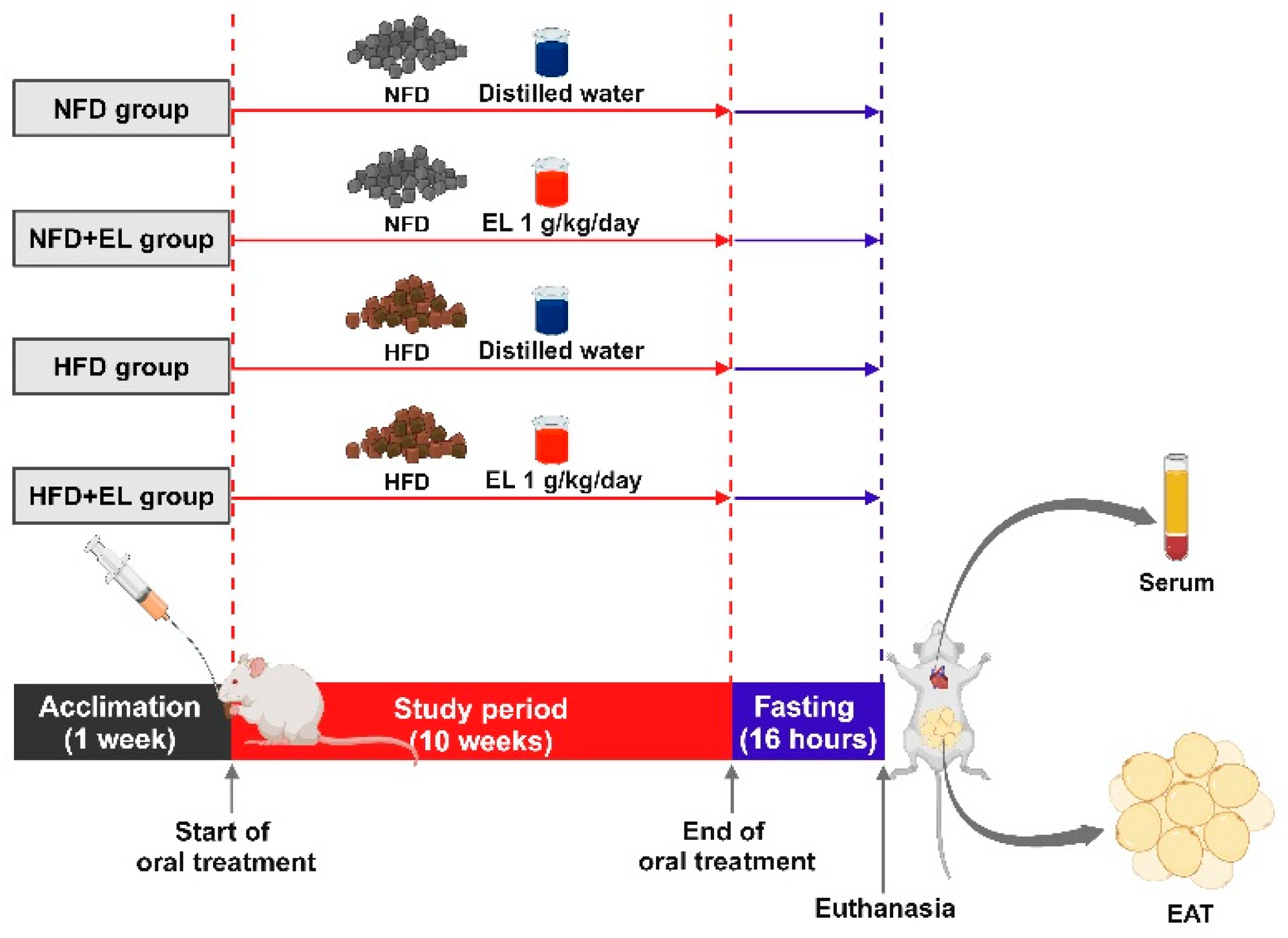
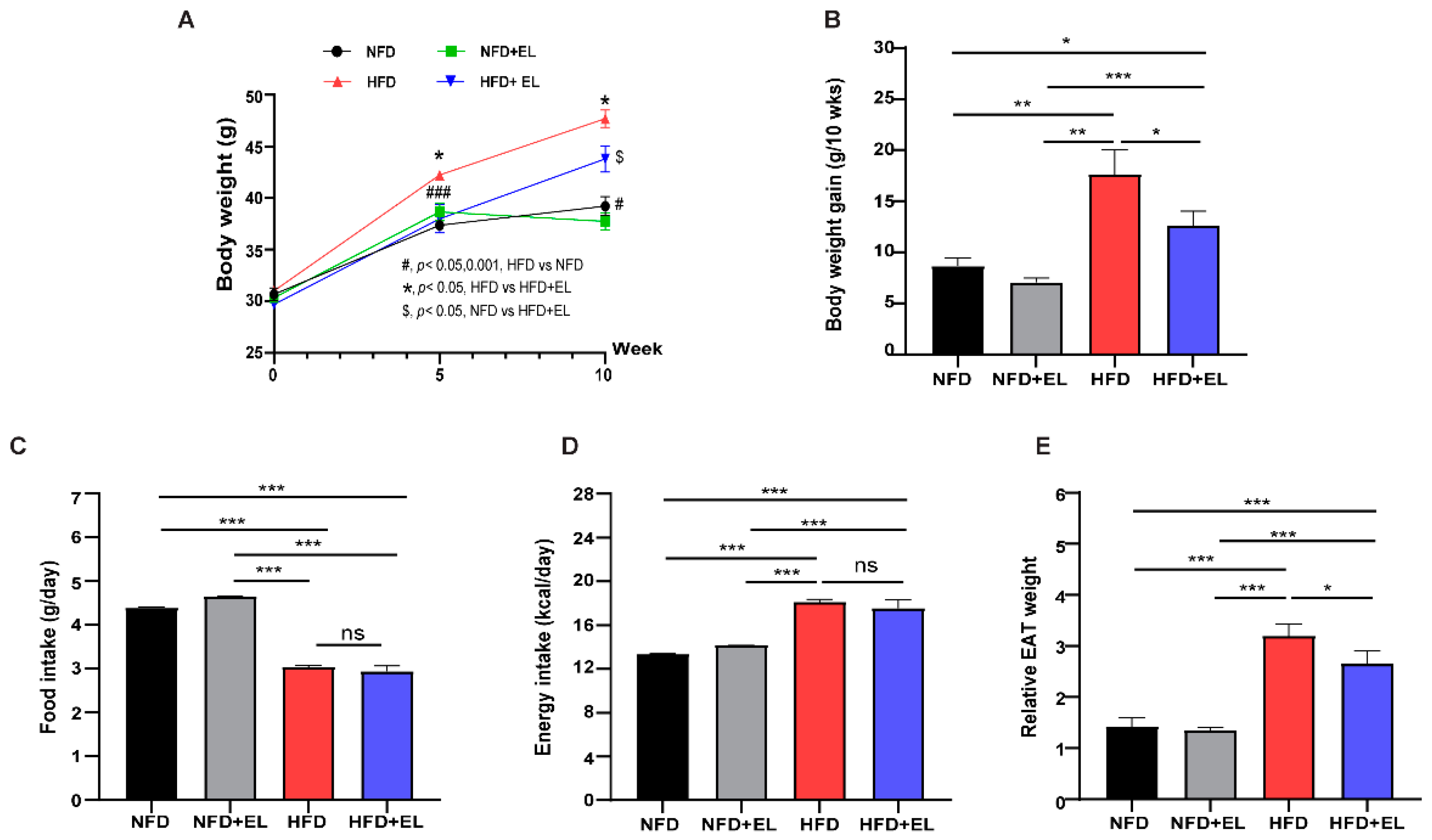
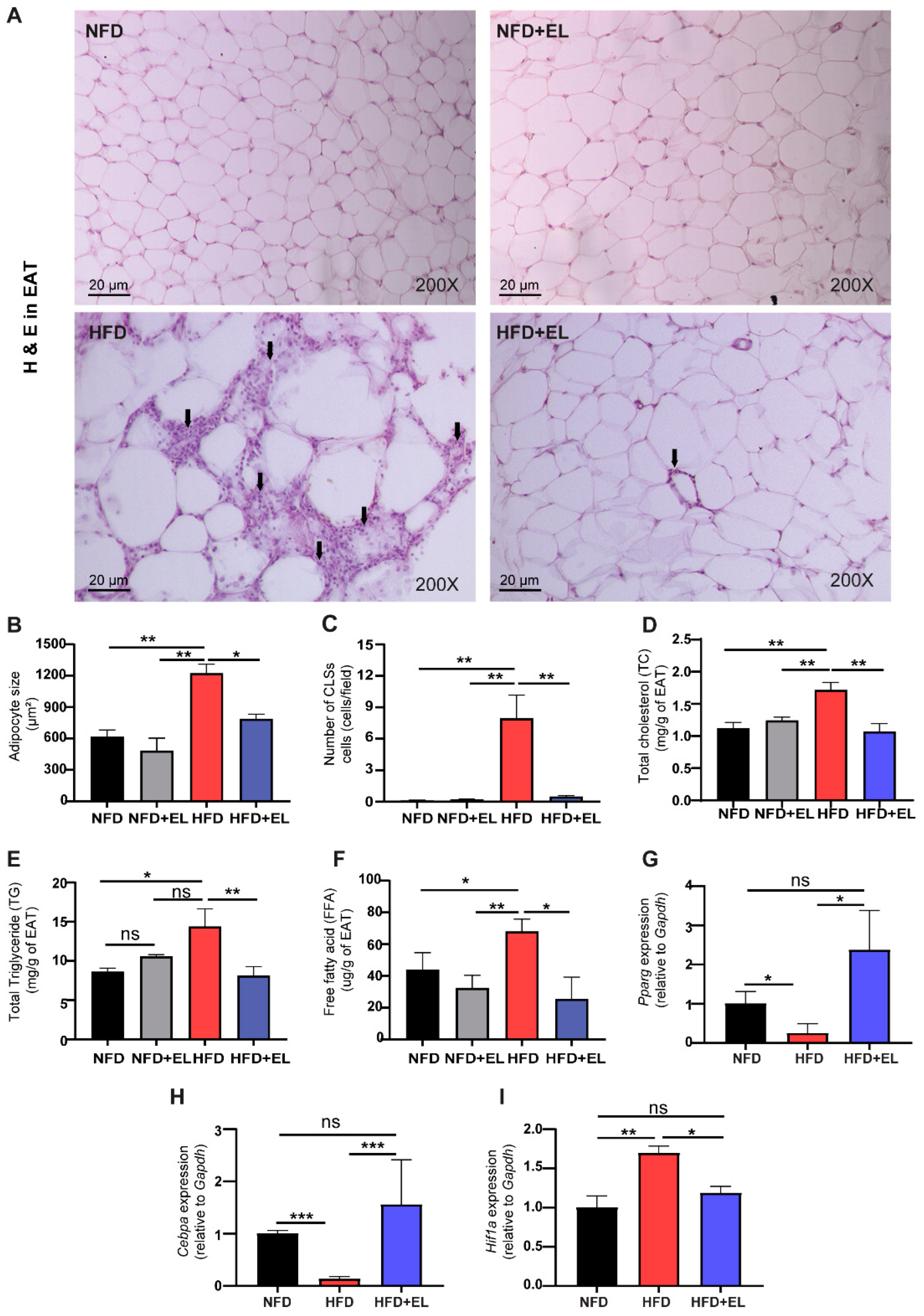
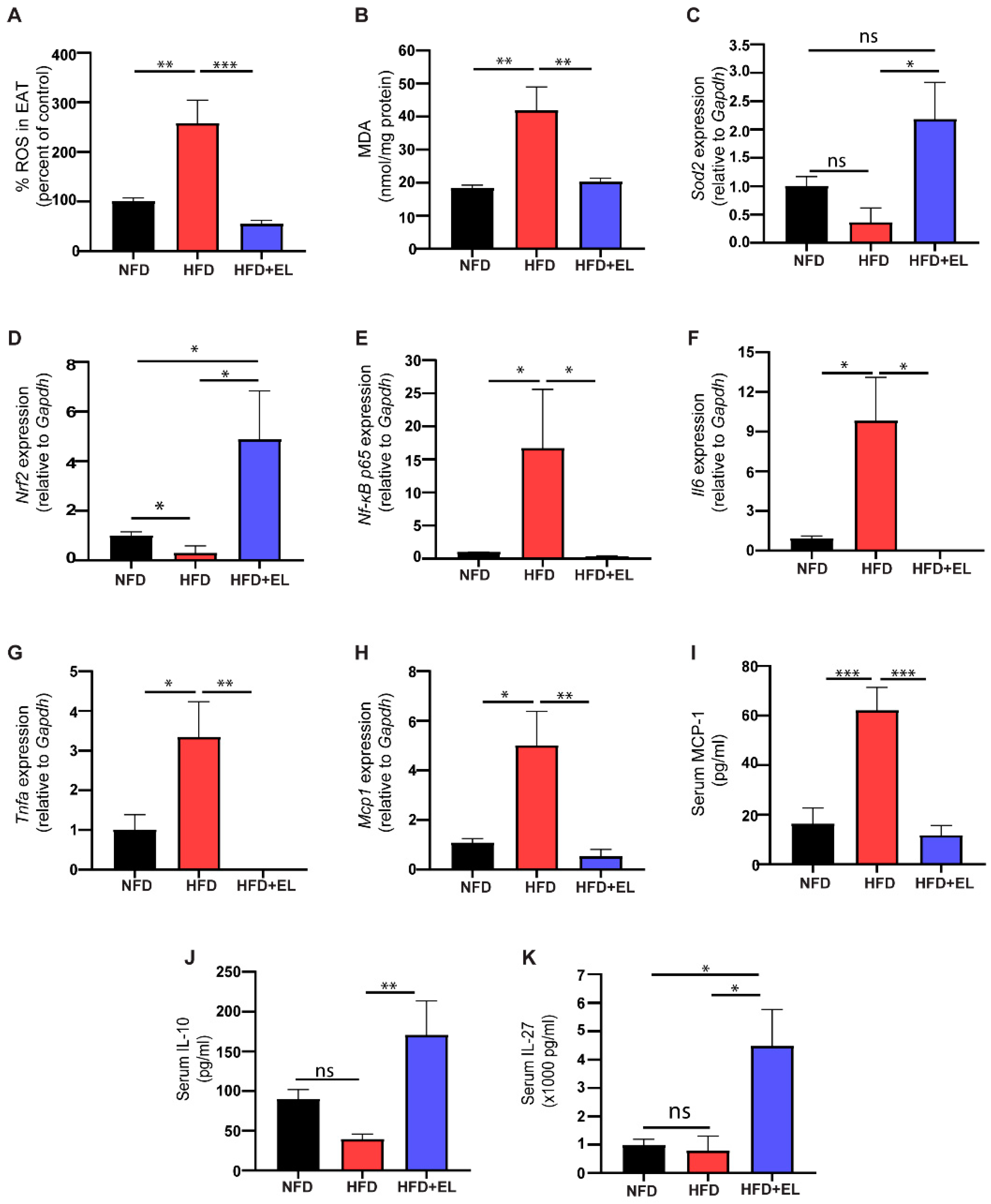
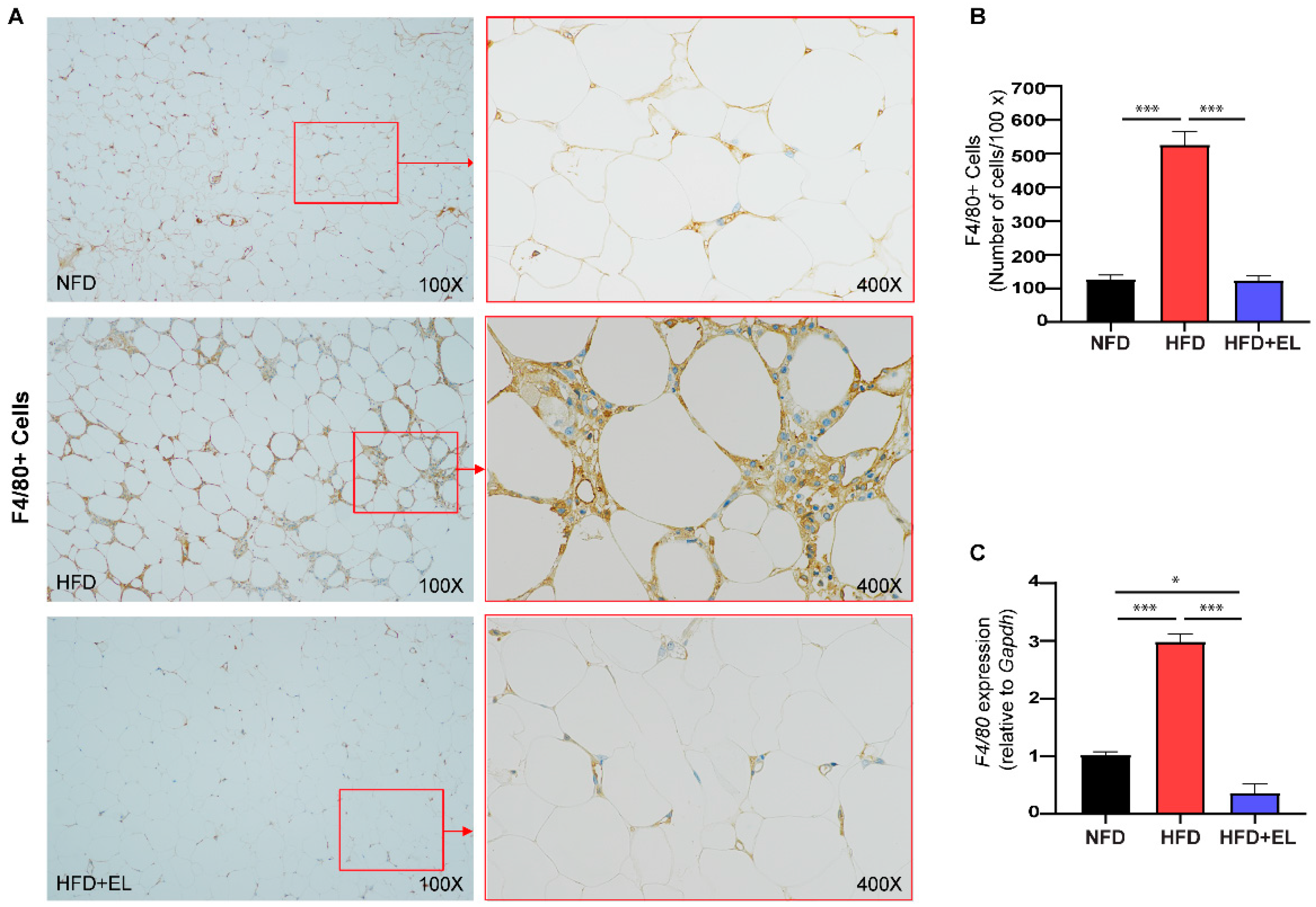
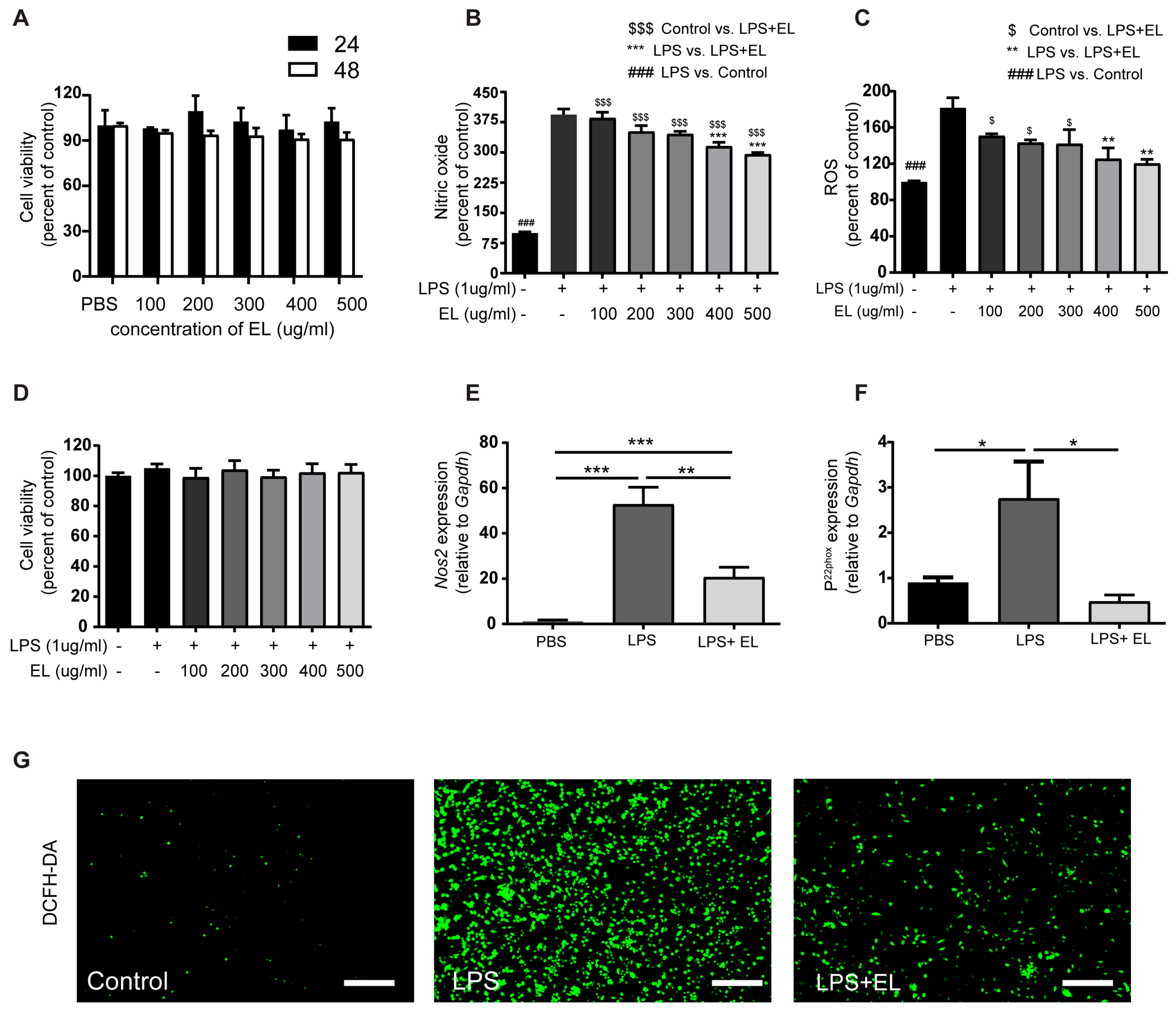
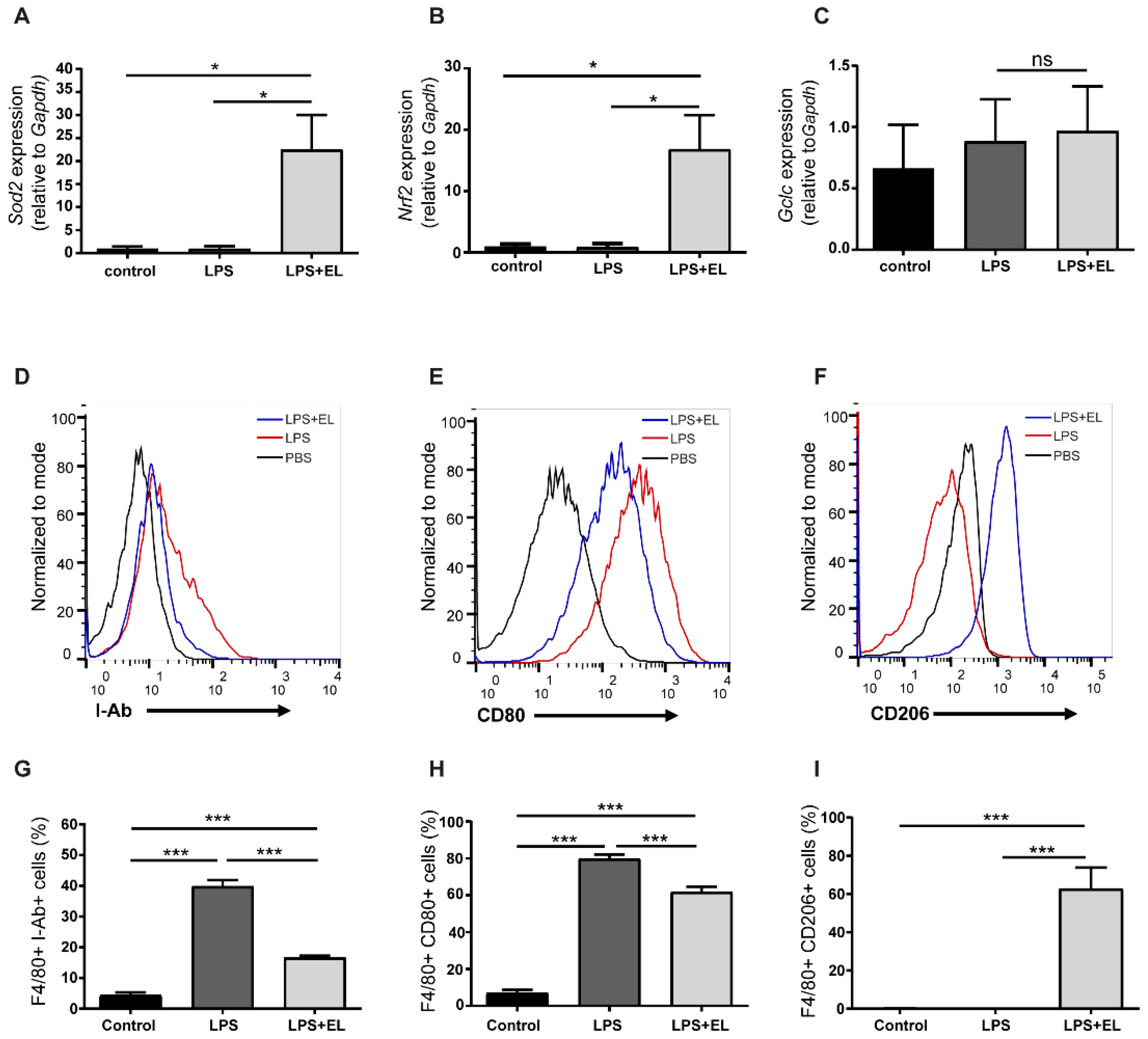
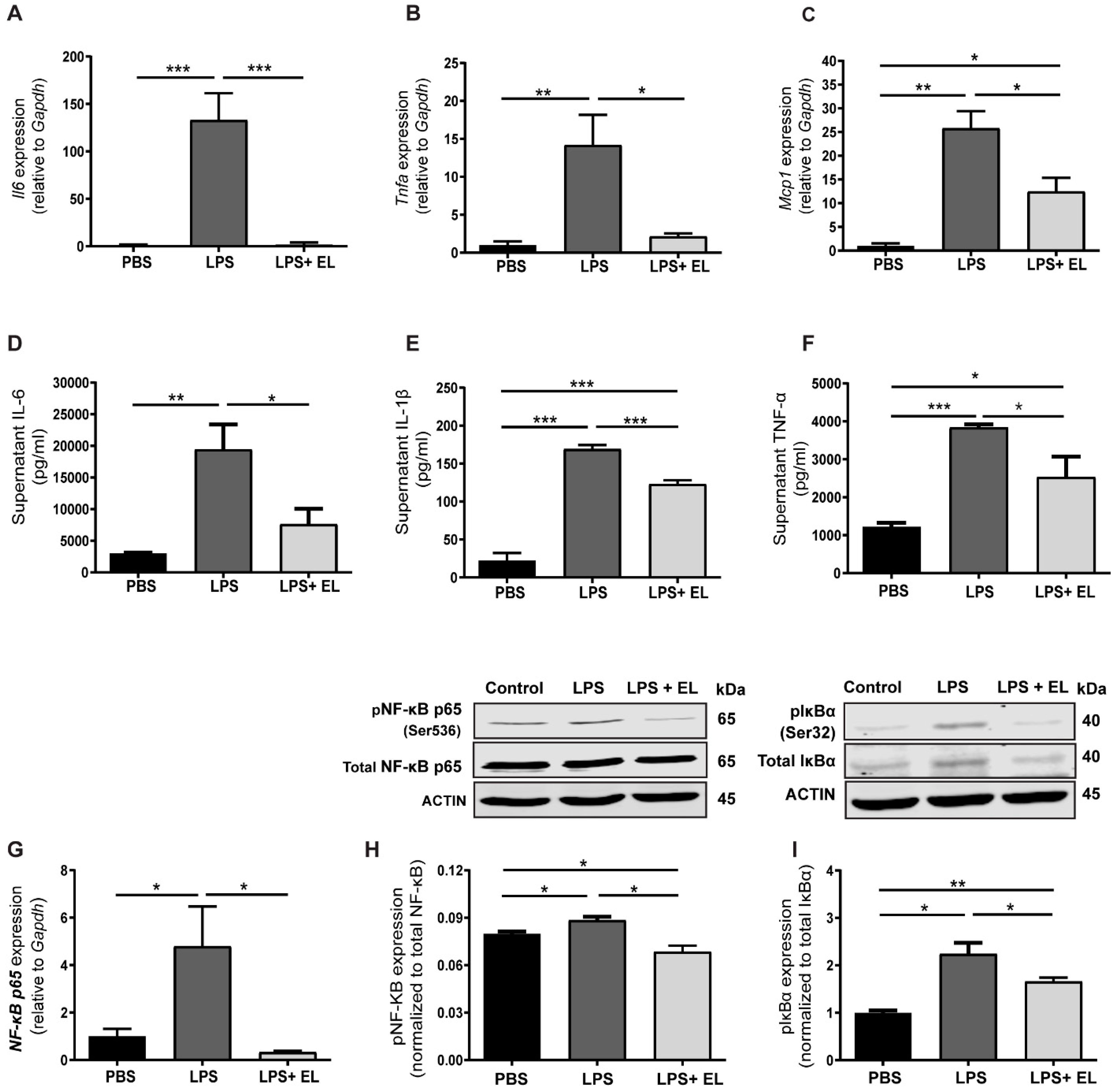
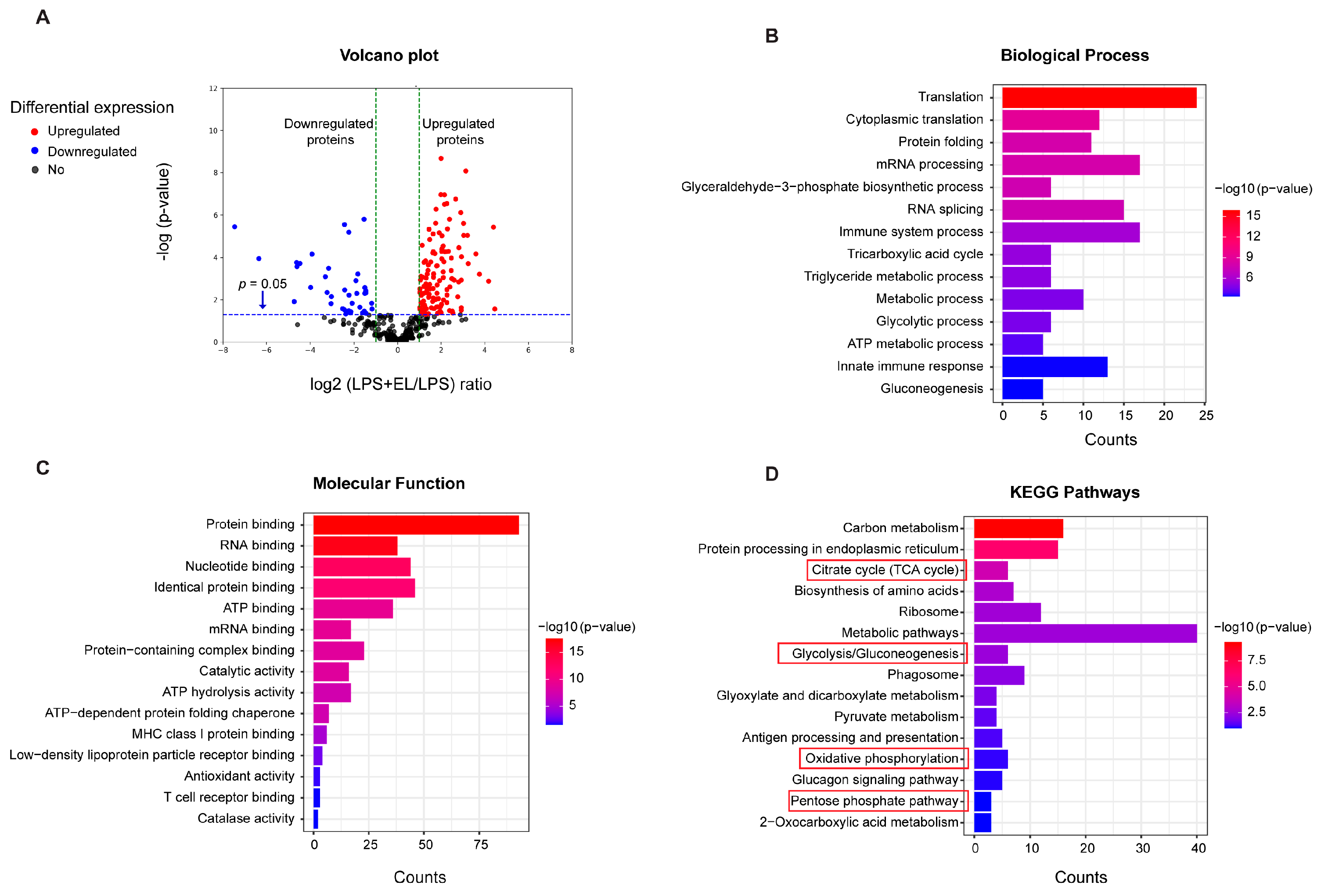
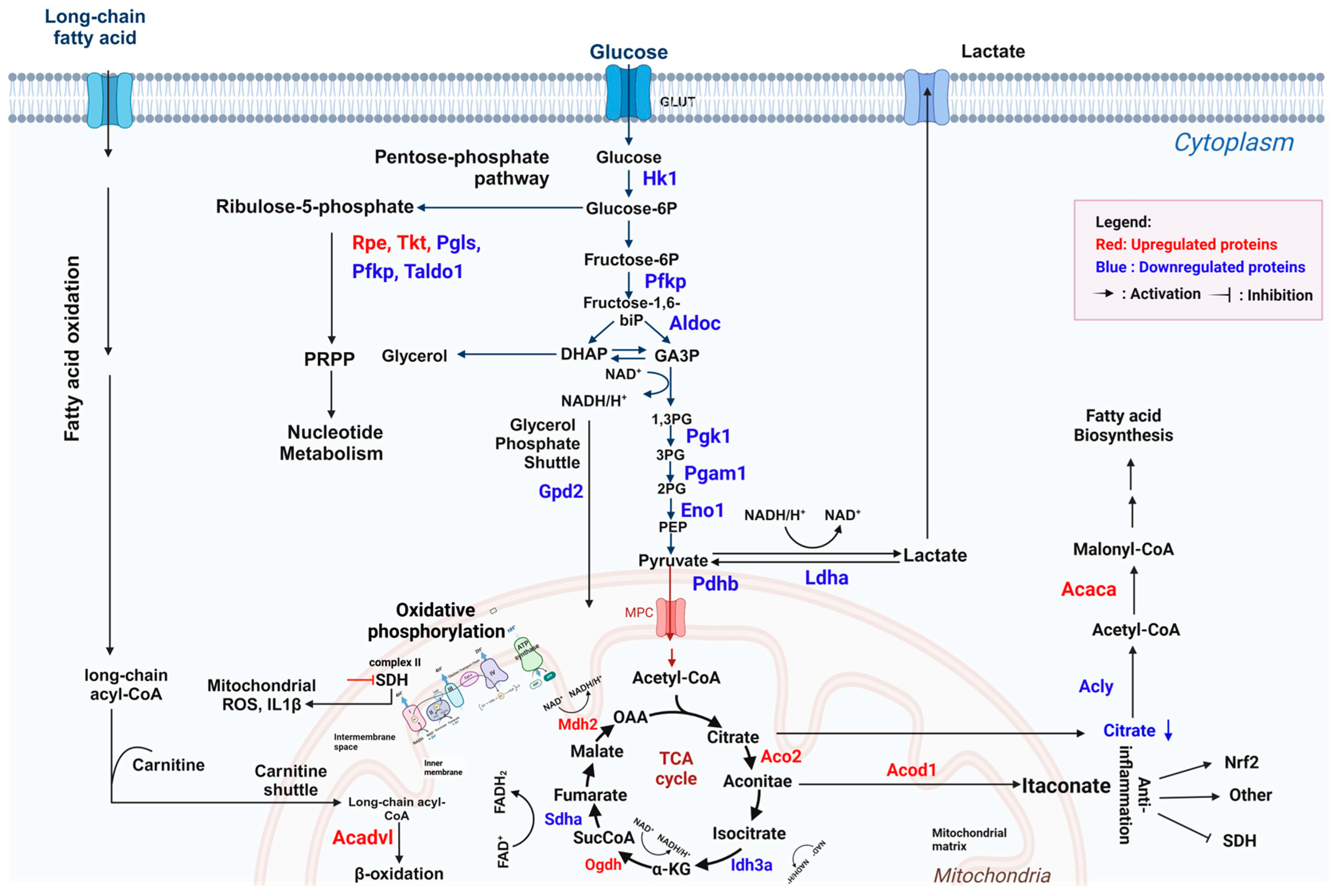
| Phytochemical Contents | Amount |
| Total phenolic content (mg of GAE/g) | 13.88 ± 0.41 |
| Total flavonoid content (mg of catechin/g) | 2.79 ± 0.10 |
| Antioxidant activity | IC50 values (µg/mL) |
| DPPH of EL | 289.96 ± 18.40 |
| DPPH of Trolox | 3.45 ± 0.28 |
| ABTS of EL | 151.30 ± 5.07 |
| ABTS of Trolox | 3.27 ± 0.07 |
| RT (min) | Mass | m/z | Identification | Chemical Formula |
|---|---|---|---|---|
| 1.721 | 98.0371 | 143.0354 | Angelica lactone | C5H6O2 |
| 1.721 | 126.0316 | 125.0244 | Phloroglucinol | C6H12O6 |
| 1.759 | 304.0952 | 349.094 | 5-hydroxy-7,3′,4′-trimethoxyflavone | C16H16O6 |
| 1.759 | 286.0481 | 331.0459 | Kaempferol | C15H10O6 |
| 7.157 | 302.0411 | 320.0751 | Quercetin | C15H10O7 |
| 7.793 | 120.0579 | 121.0667 | Phenyl acetaldehyde | C8H8O |
| 8.168 | 290.0779 | 335.0765 | Catechin | C15H14O6 |
| 10.604 | 386.1939 | 431.193 | Roseoside | C19H30O8 |
| 16.213 | 204.116 | 263.1299 | Isobutyl cinnamate | C13H16O2 |
| 16.447 | 168.0416 | 167.0343 | Elaeagpyrone | C8H8O6 |
| 16.528 | 802.1948 | 801.1886 | Isorhamnetin 3-0-{6-O-E-feruloyl)-β-d glucopyranosyl-(1-n)-β-d-galactopyranoside | C37H38O20 |
| 16.684 | 448.0991 | 447.0927 | Naringenin 7-0-P-D-glucopyranoside | C21H20O11 |
| 17.009 | 128.0838 | 187.0977 | Cyclohexane carboxylic acid | C7H12O2 |
| 17.513 | 594.1363 | 593.129 | Angustifolinoid A | C30H26O13 |
| 17.943 | 176.0836 | 221.0818 | Ethyl cinnamate | C11H12O2 |
| 17.943 | 162.0679 | 221.0818 | Methyl cinnamate | C10H10O2 |
| 18.472 | 164.0835 | 223.0974 | Phenylethyl acetate | C10H12O2 |
| 19.675 | 492.1265 | 491.119 | 5, 3′-dihydroxy-7,4′-dimethoxyflavone | C23H24O12 |
| 19.675 | 432.1052 | 491.1187 | Vitexin | C21H20O10 |
| 19.675 | 150.0677 | 209.0811 | 2-hydroxy-5-methylacetophenone | C9H10O2 |
| 20.204 | 190.0989 | 249.1127 | Isopropyl cinnamate | C12H14O2 |
| 20.204 | 204.1146 | 249.1127 | Isobutyt cinnamate | C13H16O2 |
| 21.094 | 412.369 | 435.3523 | Stigmasterol | C29H48O |
| 21.434 | 608.2757 | 609.2837 | Reserpine | C33H40N2O9 |
| 21.845 | 212.214 | 257.212 | Tridecanoic acid, methyl ester | C14H28O |
| 23.965 | 610.1508 | 633.1419 | Rutin | C27H30O16 |
| 24.298 | 978.2636 | 1001.255 | Elaeagnoside F | C44H50O25 |
| 24.355 | 576.4369 | 621.4357 | Dausosterol | C35H60O6 |
| 26.704 | 594.139 | 617.1279 | Angustifolinoid A | C30H26O13 |
Disclaimer/Publisher’s Note: The statements, opinions and data contained in all publications are solely those of the individual author(s) and contributor(s) and not of MDPI and/or the editor(s). MDPI and/or the editor(s) disclaim responsibility for any injury to people or property resulting from any ideas, methods, instructions or products referred to in the content. |
© 2024 by the authors. Licensee MDPI, Basel, Switzerland. This article is an open access article distributed under the terms and conditions of the Creative Commons Attribution (CC BY) license (https://creativecommons.org/licenses/by/4.0/).
Share and Cite
Munkong, N.; Jantarach, N.; Yoysungnoen, B.; Lonan, P.; Makjaroen, J.; Pearngam, P.; Kumpunya, S.; Ruxsanawet, K.; Nanthawong, S.; Somparn, P.; et al. Elaeagnus latifolia Fruit Extract Ameliorates High-Fat Diet-Induced Obesity in Mice and Alleviates Macrophage-Induced Inflammation in Adipocytes In Vitro. Antioxidants 2024, 13, 1485. https://doi.org/10.3390/antiox13121485
Munkong N, Jantarach N, Yoysungnoen B, Lonan P, Makjaroen J, Pearngam P, Kumpunya S, Ruxsanawet K, Nanthawong S, Somparn P, et al. Elaeagnus latifolia Fruit Extract Ameliorates High-Fat Diet-Induced Obesity in Mice and Alleviates Macrophage-Induced Inflammation in Adipocytes In Vitro. Antioxidants. 2024; 13(12):1485. https://doi.org/10.3390/antiox13121485
Chicago/Turabian StyleMunkong, Narongsuk, Nattanida Jantarach, Bhornprom Yoysungnoen, Piyanuch Lonan, Jiradej Makjaroen, Phorutai Pearngam, Sarinya Kumpunya, Kingkarnonk Ruxsanawet, Saharat Nanthawong, Poorichaya Somparn, and et al. 2024. "Elaeagnus latifolia Fruit Extract Ameliorates High-Fat Diet-Induced Obesity in Mice and Alleviates Macrophage-Induced Inflammation in Adipocytes In Vitro" Antioxidants 13, no. 12: 1485. https://doi.org/10.3390/antiox13121485
APA StyleMunkong, N., Jantarach, N., Yoysungnoen, B., Lonan, P., Makjaroen, J., Pearngam, P., Kumpunya, S., Ruxsanawet, K., Nanthawong, S., Somparn, P., & Thim-Uam, A. (2024). Elaeagnus latifolia Fruit Extract Ameliorates High-Fat Diet-Induced Obesity in Mice and Alleviates Macrophage-Induced Inflammation in Adipocytes In Vitro. Antioxidants, 13(12), 1485. https://doi.org/10.3390/antiox13121485







